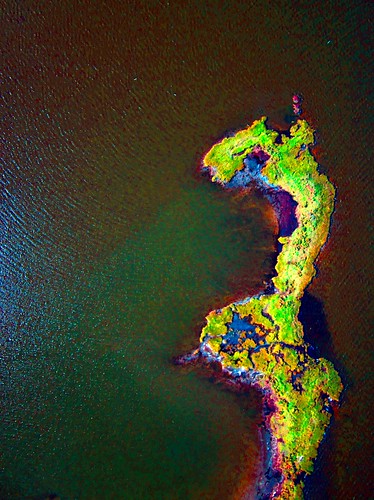Revisions for Image Analysis
| 5 CURRENT | wward1400 |
November 08, 2016 23:44
| about 8 years ago
Infrared compositingIf you have near-infrared imagery you can composite that imagery with the visible-light imagery to see how healthy the vegetation is.
Contrast adjustmentsStretch the contrast and saturation of your images to see more detail, especially underwater. Read more here:
Decorrelation stretchingNathan Craig writes: Decorrelation stretching may be a method to consider. Various flavors of the transformation are easily run using the DStretch Plugin for Image J. Several that seemed to represent variability relevant to the case study are included. I use DStretch to help bring out detail in rock art scenes that are highly eroded. However, the method has utility outside of rock art studies. It may be an additional approach to consider when trying to identify pollution or other contaminants. Here is information on DStretch http://www.dstretch.com/ Here is a paper that describes the transformation http://eospso.gsfc.nasa.gov/eos_homepage/for_scientists/atbd/docs/ASTER/atbd-ast-06.pdf ClassificationUsing the ratios of Red, Green, and Blue (and possibly Near-infrared), spectral classification attempts to categorize regions of an image by land type. Read more on the classification page »
Image Analysis[activities:image-analysis] |
Revert | |
| 4 | warren |
January 03, 2012 21:53
| about 13 years ago
Infrared compositingIf you have near-infrared imagery you can composite that imagery with the visible-light imagery to see how healthy the vegetation is.
Contrast adjustmentsStretch the contrast and saturation of your images to see more detail, especially underwater. Read more here:
Decorrelation stretchingNathan Craig writes: Decorrelation stretching may be a method to consider. Various flavors of the transformation are easily run using the DStretch Plugin for Image J. Several that seemed to represent variability relevant to the case study are included. I use DStretch to help bring out detail in rock art scenes that are highly eroded. However, the method has utility outside of rock art studies. It may be an additional approach to consider when trying to identify pollution or other contaminants. Here is information on DStretch http://www.dstretch.com/ Here is a paper that describes the transformation http://eospso.gsfc.nasa.gov/eos_homepage/for_scientists/atbd/docs/ASTER/atbd-ast-06.pdf ClassificationUsing the ratios of Red, Green, and Blue (and possibly Near-infrared), spectral classification attempts to categorize regions of an image by land type. Read more on the classification page »
|
Revert | |
| 3 | warren |
January 03, 2012 21:52
| about 13 years ago
Infrared compositingIf you have near-infrared imagery you can composite that imagery with the visible-light imagery to see how healthy the vegetation is.
Contrast adjustmentsStretch the contrast and saturation of your images to see more detail, especially underwater. Read more here:
Decorrelation stretchingNathan Craig writes: Decorrelation stretching may be a method to consider. Various flavors of the transformation are easily run using the DStretch Plugin for Image J. Several that seemed to represent variability relevant to the case study are included. I use DStretch to help bring out detail in rock art scenes that are highly eroded. However, the method has utility outside of rock art studies. It may be an additional approach to consider when trying to identify pollution or other contaminants. Here is information on DStretch http://www.dstretch.com/ Here is a paper that describes the transformation http://eospso.gsfc.nasa.gov/eos_homepage/for_scientists/atbd/docs/ASTER/atbd-ast-06.pdf ClassificationUsing the ratios of Red, Green, and Blue (and possibly Near-infrared), spectral classification attempts to categorize regions of an image by land type. Read more on the classification page »
|
Revert | |
| 2 | warren |
October 27, 2011 21:49
| about 13 years ago
Infrared compositingIf you have near-infrared imagery you can composite that imagery with the visible-light imagery to see how healthy the vegetation is.
Contrast adjustmentsStretch the contrast and saturation of your images to see more detail, especially underwater. Read more here:
Decorrelation stretchingNathan Craig writes: Decorrelation stretching may be a method to consider. Various flavors of the transformation are easily run using the DStretch Plugin for Image J. Several that seemed to represent variability relevant to the case study are included. I use DStretch to help bring out detail in rock art scenes that are highly eroded. However, the method has utility outside of rock art studies. It may be an additional approach to consider when trying to identify pollution or other contaminants. Here is information on DStretch http://www.dstretch.com/ Here is a paper that describes the transformation http://eospso.gsfc.nasa.gov/eos_homepage/for_scientists/atbd/docs/ASTER/atbd-ast-06.pdf ClassificationUsing the ratios of Red, Green, and Blue (and possibly Near-infrared), spectral classification attempts to categorize regions of an image by land type.
|
Revert | |
| 1 | warren |
October 27, 2011 21:49
| about 13 years ago
Infrared compositingIf you have near-infrared imagery you can composite that imagery with the visible-light imagery to see how healthy the vegetation is.
Contrast adjustmentsStretch the contrast and saturation of your images to see more detail, especially underwater. Read more here:
Decorrelation stretchingNathan Craig writes: Decorrelation stretching may be a method to consider. Various flavors of the transformation are easily run using the DStretch Plugin for Image J. Several that seemed to represent variability relevant to the case study are included. I use DStretch to help bring out detail in rock art scenes that are highly eroded. However, the method has utility outside of rock art studies. It may be an additional approach to consider when trying to identify pollution or other contaminants. Here is information on DStretch http://www.dstretch.com/ Here is a paper that describes the transformation http://eospso.gsfc.nasa.gov/eos_homepage/for_scientists/atbd/docs/ASTER/atbd-ast-06.pdf ClassificationUsing the ratios of Red, Green, and Blue (and possibly Near-infrared), spectral classification attempts to categorize regions of an image by land type.
|
Revert | |
| 0 | warren |
October 27, 2011 20:35
| about 13 years ago
Infrared compositingIf you have near-infrared imagery you can composite that imagery with the visible-light imagery to see how healthy the vegetation is.
Contrast adjustmentsStretch the contrast and saturation of your images to see more detail, especially underwater. Read more here:
... |
Revert |




